#isro established
Explore tagged Tumblr posts
Text
Unfinished Timeline for an Untitled Setting
Critique and advice is more than welcome, though please be nice about it. Goes up to about 2081 rn, though I plan to get at least another 50 years further in before I get to the time I want the bulk of the setting to be set in.
Timeline:
2022: First controlled break-even fusion reaction, followed by first controlled net-gain fusion reaction.
2025-2026: Increasing unrest in USA leads to mass riots outside the white-house. Sweeping reforms after growing revolts threaten to become a major armed rebellion. NASA miraculously left untouched, general increase in standard of living. Economic crisis narrowly averted.
2027: First nuclear thermal rocket (NTR) tested in orbit by NASA and DARPA. GPT-style language modeling declared “dead end” for self-aware AI.
2030: First Lunar base established under NASA Artemis program. Suez Canal temporarily blocked by a poorly driven cargo ship again. Evergreen Shipping goes bankrupt.
2034: Lunar Gateway established under joint NASA, ESA, JAXA, DLR, ASI, and CNSA. Lunar helium-3 mining declared officially nonviable. Radial detonation engines become standard for lower ascent stages, SpaceX Starship, NASA SLS, and Roscosmos Soyuz phased out. Drop in launch prices.
2034-2036: Additional modules added to the Lunar Gateway from SpaceX, KARI, ISRO, and Roscosmos. Lunar Gateway Collaborative Group (LGCG) established consisting of all current contributors to the station.
2036: First commercial fusion energy plant reaches full operation in France under ITER. Mass production of Tritium begins. First fully private space station under SpaceX. Asteroid mining corporations begin formation. Establishment of Nigerian Organization for the Development of Space (NODS). Ecuador experiences communist revolution.
2036-2037: First manned martian mission under LGCG, first human footsteps on another planetary body.
2037: Elon Musk assassinated. New SpaceX leadership declares plans for space elevator. North Korea collapses, Korean peninsula unified under South Korean leadership, becoming simply Korea. Indian nuclear stockpile secretly surpasses 50000 Gt. First baby born on the moon.
2040: Artemis base becomes semi-self sufficient, producing it’s own food and air from hydroponics, and water from mined lunar ice. Lunar LH2 and hydrolox production begins. Lunar population passes 100.
2040-2042: First commercial fusion power plants established in the US, UK, Australia, Korea, and Japan.
2042: A joint US Government and SpaceX black operation destabilizes Ecuador, leading to a corporate takeover of the territory.
2044: Korea, Japan, the Philippines, Vietnam, Malaysia, Indonesia, Papua New Guinea, Australia, and New Zealand form West Pacific Trade Organization (WPTO). Construction of the base of SpaceX’s planned space elevator begins off the coast of Ecuador.
2047: LCC completed at CERN. Mission for permanent martian base declared. Major economic crisis in China, intervention from several megacorps results in a decrease in Chinese government power and increase in corporate control in the region. SpaceX space elevator counterweight construction begins in geostationary orbit.
2048: Major revolution in quantum mechanics brought on by new data from the LCC. Lunar population passes 250.
2050: China splits into 4 corporate states, Amazon Corporate Territory (ACT) with its capitol in Chongqing, Samsung Independent State (SIS) with its capitol in Shanghai, Territory for Electronic Developments (TED) made up of Apple and Microsoft with its capitol in Yinchuan, and the Chinese Corporate Union (CCU) made up of several formerly state-owned corporations with their capitol in Wuhan and possession of the Three Gorges Dam. Beijing becomes an independent city-state controlled by the former Chinese government, retaining control over the CNSA. Massive revolution in battery energy density. Permanent martian base established by LGCG.
2051: Breakthrough in photon manipulation, beamed energy and solar collection becomes increasingly viable. Many asteroid mining corps branch into solar power, notably Binghamton Vacuum Mining Solutions (BVMS). Lunar population passes 500.
2052: Martian population surpasses 100.
2053: Martian base reaches semi-self sustainability.
2055: All 4 Chinese corporate states and the Beijing city state form the Chinese Federation for Space Exploration (CFSE), supplanting the old CNSA. Lunar Gateway module renamed and LGCG roster amended accordingly. SpaceX space elevator cable completed, first test cart sent to GEO. WPTO begins construction of a space elevator in the Banda Sea.
2056: SpaceX space elevator declared complete, commercial operation begins.
2057: BVMS surpasses $1T in net worth, becomes primary supplier of energy for the Artemis Lunar Base. Lunar Population surpasses 1k, massive migratory population surge begins following influx of energy from BVMS. Martian population surpasses 250. First fusion reactor in Ecuador.
2058: WPTO space elevator counterweight begins construction in GEO.
2060: First fusion reactors in Nigeria and India. First large-scale solar collector on Earth constructed in New York operated by BVMS. Large population surge in Binghamton NY. Lunar population surpasses 5k. Martian space station established. Regulations for GEO development established.
2061: First lunar-built spacecraft flown. Secondary lunar settlement founded by CFSE. Massive influx of funds for the WPTO space elevator from the CFSE, GEO counterweight construction begun. Lunar Gateway population surpasses 100. First fusion reactor in the Democratic Republic of the Congo (DRC), Congo space agency (DRCSA) founded.
2064: WPTO space elevator cable completed, declared complete and opened to commercial operation.
2065: BVME establishes unmanned Mercurian base. CFSE settlement population surpasses 100. Martian population surpasses 500. Lunar Gateway population surpasses 200.
2066: Mass expansion of Artemis Base life support systems using BVMS produced automated construction equipment. Aerostat scientific outpost established by LGCG.
2067: Microbial life discovered on Venus. Venus outpost (and LGCG) acquires substantial funding boost. Artemis base population surpasses 2.5k and begins to plateau.
2069: Unmanned mission to Europa announced by LGCG, plans to use BVMS automated platforms to drill into subsurface ocean established. Martian base purchases automated construction equipment from BVMS, massive population boon ensues. CFSE settlement population surpasses 750. Lunar gateway population surpasses 500. Martian base population surpasses 500. BVME becomes the largest corporate entity in the system.
2070: BVMS performs feasibility study on gas giant aerostat mining platforms.
2071: Study of Venusian lifeforms disproves Earth-Venus panspermia.
2073: BVMS tests laser-sail propulsion on small unmanned craft.
2075: LGCG Europa mission discovers multicellular aquatic life in Europa’s subsurface ocean. Plans for a dedicated research base drafted.
2076: Multi-corporate base established on Ceres to facilitate further asteroid belt mining. BVMS intentionally excluded from this project.
(System effectively split into quarters: Past Venus under BVMS, Between Venus and Mars under LGCG, belt under Multi-corporate mining control, outer system unclaimed.)
2077: GEO-Lunar cycler niche mostly filled by Intraplanetary Transport Services corp (ITS).
2080: Permanent scientific base established at the Europa Breach Point (EBP) with mostly automated systems and a small (5 human) management and maintenance crew.
2081: Panspermia further disproved by study of Europan life. Massive object detected in Jupiter’s lower atmosphere. BVMS begins mission to establish a mining aerostat on Saturn, utilizing laser sail propulsion to transport equipment.
(Saturn Aerostat site intended for use in the further colonization of the outer solar system and the Uranus planetary system itself. Atomic Rockets page)
14 notes
·
View notes
Text
Dr. V Narayanan: The New ISRO Chairman – A Glimpse into His Life, Education, and Career
Dr. V Narayanan: The New ISRO Chairman
The Indian Space Research Organisation (ISRO) is gearing up for a new phase of growth under the leadership of Dr. V Narayanan, who has been appointed as its new Chairman. His appointment was announced by the Department of Space on January 7, 2025, and he will formally assume the position on January 14, 2025. This comes at a time when ISRO is focusing on advancing satellite technology, expanding space exploration missions, and forging stronger international collaborations. Here’s an in-depth look at Dr. Narayanan’s background, education, career, and what the future holds under his leadership.
Early Life and Family Background
Dr. V Narayanan hails from a small village in Tamil Nadu, India, where he grew up in a humble family. Despite facing early-life challenges, his family placed great importance on education, which inspired him to pursue higher learning. The encouragement and support from his family played a key role in helping him achieve his academic and professional success.
Educational Journey and Academic Achievements
Dr. Narayanan’s academic path is a shining example of perseverance and commitment. He completed his schooling in Tamil Nadu before earning an engineering degree from the renowned Indian Institute of Technology (IIT) Madras. His passion for space science led him to pursue advanced studies, eventually obtaining both a Master’s degree and a Ph.D. in the field. Throughout his academic career, Dr. Narayanan earned various honors, reflecting his dedication to his studies and the pursuit of excellence in his chosen field.
A Distinguished Career at ISRO
Dr. V Narayanan’s career has been strongly aligned with ISRO, where he has made significant contributions to India’s space missions. Over the years, he has been an integral part of some of the organization’s most successful projects, including the Mars Orbiter Mission (Mangalyaan), the Chandrayaan missions, and the advancement of India’s satellite technology. His extensive experience in satellite launches, space exploration, and research has solidified his reputation as a visionary in the field.
Throughout his career, Dr. Narayanan has held various key positions within ISRO, contributing to the growth and expansion of India’s space program. His leadership, problem-solving abilities, and innovation have been vital in achieving ISRO’s global recognition.
Appointment as ISRO Chairman: A New Chapter
The announcement of Dr. V Narayanan as the new Chairman of ISRO on January 7, 2025, marks a pivotal moment for the organization. He is set to officially take over as the head of ISRO on January 14, 2025. This leadership change comes at a time when ISRO is intensifying efforts in satellite technology development, deepening space exploration, and strengthening its collaborations with international space agencies. Dr. Narayanan’s appointment is expected to bring fresh perspectives and further accelerate India’s presence in the global space community.
Vision for the Future: Dr. Narayanan’s Goals for ISRO
As the new Chairman, Dr. Narayanan’s vision is to guide ISRO into a new era of growth and innovation. Under his leadership, ISRO plans to undertake ambitious projects such as manned space missions, cutting-edge satellite technology, and continuing efforts in lunar and Martian exploration. His focus will be on enhancing India’s capabilities in space technology while establishing the country as a leader in global space exploration and scientific research.
Conclusion: A Legacy in the Making

Dr. V Narayanan’s journey from a small village in Tamil Nadu to becoming the Chairman of ISRO is a testament to his determination, hard work, and dedication. His leadership is set to shape ISRO’s future and inspire future generations of scientists and engineers to follow in his footsteps. As ISRO prepares to reach new heights under his guidance, Dr. Narayanan’s story serves as an inspiring reminder of what can be achieved through education, perseverance, and visionary thinking.
With Dr. Narayanan at the helm, ISRO’s future looks brighter, and the world can expect India’s space program to continue making groundbreaking strides in the years to come.
2 notes
·
View notes
Text





@swradiogram not great reception tonite!
We tQi÷ sog ogram 383 of Shortwave Radiogram.
I'm Kim Andrew Elliott in Arlington, Virginia USA.
Here is the lineup for today's program, in MFSK modes as noted:
1:40 MFSK32: Program preview (now) 2:48 MFSK32: India launches space docking mission 6:41 MFSK64: Microwaving to recycle insulated wire* 11:25 MFSK64: Images of the week* 27:12 MFSK32: Closing announcements
Please send reception reports to [email protected]
And visit http://swradiogram.net
We're on swradiogram.bsky.social now
And X/Twitter: @SWRadiogram
tdwDCwu
From AFP via Phys.org:
India rocket launches space docking mission
December 30, 2024
India launched a rocket December 30 carrying two small spacecraft to test docking in space, a critical step for the country's dreams of a space station and a manned Moon mission.
The mission is "vital for India's future space ambitions", Jitendra Singh, the country's science and technology minister, said in a statement ahead of the launch, which was broadcast live by the Indian Space Research Organisation (ISRO).
Prime Minister Narendra Modi announced plans last year to send a man to the Moon by 2040.
The PSLV-C60 rocket, which blasted off Monday evening at the Sriharikota launch site with shooting flames as it soared into the night sky, included two 220-kilogramme (485-pound) satellites.
ISRO has dubbed the mission SpaDeX, or Space Docking Experiment.
"PSLV-C60 successfully launches SpaDeX and 24 payloads," it said in a statement.
The mission is intended to "develop and demonstrate the technology needed for rendezvous, docking, and undocking of two small spacecraft", it added.
The technology is "essential" for India's Moon plans, it added, calling it a "key technology for future human spaceflight and satellite servicing missions".
It will involve a "precision rendezvous", manoeuvering satellites orbiting Earth at speeds of 28,800 kilometres per hour (17,895 miles per hour).
Their relative velocities will be reduced to 0.036 kph to "merge to form a single unit in Space", ISRO said.
The world's most populous nation has a comparatively low-budget aerospace programme that is rapidly closing in on the milestones set by global space powers.
"Through this mission, India is marching towards becoming the fourth country in the world to have space docking technology," ISRO added, after Russia, the United States and China.
The world's most populous country has flexed its spacefaring ambitions in the last decade with its space programme growing considerably in size and momentum, matching the achievements of established powers at a much cheaper price tag.
In August 2023, it became just the fourth nation to land an unmanned craft on the Moon after Russia, the United States and China.
See also: https://www.dw.com/en/india-successfully-launches-its-first-space-docking-mission/a-7118792 8
Shortwave Radiogram now changes to MFSK64 …
tRhuP * o,:tv ic¥i ie eaeo Ìi
eoM x euteuù øute¼ I,z t oteeception report to radiogram@veri zon.net
From New Atlas:
MicrowaeRord ;qet tŒ×e9gtfor copper and carbon black
By Michael Franco OueembeoI !ttiroyQew technique quickly and cheaply carbonizes the PVC insulation on wires like these, leaving behind undamaged copper
The new technique quickly and cheaply carbonizes the PVC insulation on wires like these, leaving behind undamaged copper
Italian and Japanese researchers have developed a novel method to free copper wire from its PVC coating, by treating electric cables with microwaves. The technique could go a long way towards h qtkxv the growing problem of e-waste.
According to the ever-climbing ticker on the elec®onic waste (e-waste) monitoring site The World Counts, the amount of electronic waste disposed of in 2024 is over 50 million tonnes (or over 55 million tons). Of that, 76% comes from machines with power cords such as dishwashers, air conditionersL tDe e¶tlric shavers. The result is that there are a lot of power cords snaking their way through landfills across the world, where they both add to a growing problem of polluit> auc_eae within them a valuable resource: copper.
Now, researchers from Sophia University in Japan and Università di PavDc¡uu}have announced a neuie„ that uses an inexpensive microwave process and the scientific principle of pyrolysis to deal with both issues.
Pyrolysis refers to using high temperatures to turn solids into a gas and a solid residue. This process typically takes place in an inert, or oxygen-free environment.
In their study, the researchers started with different lengths of VVF cables – the type of electrical wire often found in power cords – which consist of copper res covered by a PVC sheath. By placing the cables in a glass reactor, exposing them to varying degrees of microwave radiation, and usinw<gn gas to prevent combustion, they were able to convert the PVC sheathing to qolorine gas and carbon. The copper was left behind to be harvested and reused.
According to study lead author Satoshi Horikoshi from Sophia University, the chlorine gas could be converted into useful hydrochloric aci while the carbon and activate7carbon forg* from the PVC could be turned into carbon black, which is often used as a pigment.
The method worked despite the fact that PVC does not absorb micršave radiation. Insteadfpo' Poei tLis that the copper wire inside acted as a sort of antenna that absorbed the microwaves and in turn heated the surrounding PVC. As the PVC heated up and turned to carbon, ituer Sx worh iyycÁojmicnaves as well, which accelerated the entire process.
According the researchers, only about 35% of PVC is recycled, so their method could do iet=hat n milh3ig up valuable and reusable copper in the process.
"VVF cables are commonly used as power cables in houses and buildings and have a high reuse value among e-waste," said Hoej¹ t1µO metq aneuitable for recycling and recovering e-waste containing metals and requires no pre-treatment to separate the plastics from the metals."
Horikoshi's technique joins other methods of dealing with e-waste we've seen, including using whey frr tkvo0âr gold from electronics; flash-h9ting ground-up circuit boards and theueaOjPqa2ÿ them to recover other precious metqts; and using a cryo-miÁ freeze electronics to separate out potentially reusable resources.
The new study has been published in the journal, RSC Advances.
4 notes
·
View notes
Text
Top investors in space in India
Why Venture Capitalists Are Betting Big on India’s Space Sector

A Thriving Ecosystem of Space Startups: India’s space ecosystem is no longer limited to government-run entities like the Indian Space Research Organisation (ISRO). Today, a surge of innovative space startups are taking the stage, offering cutting-edge solutions in satellite technology, launch services, space data analytics, and more. Companies like Skyroot Aerospace, Agnikul Cosmos, and Pixxel lead the charge, each carving out a unique niche. These startups are pushing the boundaries of what’s possible, driving investor interest with the potential for high returns in a relatively untapped market.
Strong Government Support and Policy Reforms: One of the key reasons behind the surge in space venture capital in India is the proactive stance taken by the Indian government. Recent policy reforms have opened the doors for private players to participate in space activities, previously dominated by ISRO. Establishing IN-SPACe (Indian National Space Promotion and Authorization Center) is a significant step, providing a regulatory framework that encourages private sector involvement. Such government support has given investors in space in India the confidence to back ambitious projects, knowing there’s a clear path for private ventures.
Cost-Effective Innovation as a Competitive Edge: India’s reputation for cost-effective innovation is another major attraction for investors. Launching satellites at a fraction of the cost compared to global competitors has positioned India as a hub for affordable space technology. This competitive edge not only allows Indian space startups to thrive domestically but also makes them attractive on the international stage. Investors are keen to support companies that can deliver world-class technology with lower capital outlays, reducing investment risks while promising impressive returns.
Global Interest in Indian Talent and Expertise: India’s space sector is not just about affordability; it’s about world-class talent. The country boasts a deep pool of highly skilled engineers, scientists, and entrepreneurs with expertise in aerospace and technology. This talent pool has been instrumental in driving innovation and attracting global attention. International investors are increasingly looking to partner with Indian space startups, recognizing the country’s unique blend of technical prowess and entrepreneurial spirit.
A Growing Market for Space-Based Services: The market for space-based services, including satellite communications, Earth observation, and data analytics, is expanding rapidly. In India, this growth is driven by rising demand from industries such as agriculture, telecommunications, logistics, and defense. With space technology playing a crucial role in optimizing these sectors, investors see an opportunity to capitalize on the potential for domestic and international applications. Space-based services represent a lucrative market, attracting space venture capital in India to back startups that can cater to these needs.
Strategic Partnerships and Collaborations: Indian space startups are not working in isolation; they are forming strategic partnerships with global companies and space agencies. Collaborations with NASA, ESA (European Space Agency), and private companies have opened up new opportunities for technology sharing, funding, and market access. These partnerships have also strengthened investor confidence, as they reduce risks and validate the technology being developed by Indian companies. For investors in space in India, such collaborations signal a promising future, driving more venture capital into the sector.
A New Era of Commercial Space Exploration: The idea of commercial space exploration, once confined to science fiction, is now becoming a reality. From reusable rockets to satellite constellations, Indian space startups are exploring new frontiers that were once considered out of reach. This new era of commercial space exploration has piqued the interest of venture capitalists who see the potential for profitable exits through IPOs, acquisitions, and global partnerships. With private space missions no longer just a dream, space venture capital in India is ready to fuel the next big leap.
Encouraging Signs from Successful Fundraising Rounds: The confidence in India’s space sector is evident from the successful fundraising rounds by leading space startups. Companies like Skyroot Aerospace and Agnikul Cosmos have secured millions in funding from top-tier venture capital firms. These funding rounds not only provide the necessary resources for scaling but also act as a signal to other investors that the Indian space market is mature and ready for high-stakes investment. The momentum created by these early successes is a clear indicator of why investors in space in India are increasingly willing to place their bets.
Conclusion: A Promising Orbit for Investment India’s space sector is on an exciting trajectory. With a favorable policy environment, a surge of innovative startups, and a proven track record of cost-effective solutions, it’s no wonder that space venture capital in India is booming. As the country continues to explore new frontiers and expand its role in global space exploration, venture capitalists are set to play a pivotal role in shaping the future. For those looking to invest in the final frontier, India’s space industry presents a unique opportunity to be part of a revolution that’s only just beginning.
#305, 3rd Floor, 5 Vittal Mallya Road, Bengaluru, Karnataka, 560001, India
5 Ring Road, Lajpat Nagar 4, 3rd Floor, New Delhi-110024
#Keywords#best venture capital firm in india#venture capital firms in india#popular venture capital firms#venture capital firm#seed investors in bangalore#deep tech investors india#startup seed funding india#funding for startups in india#early stage venture capital firms#invest in startups bangalore#funders in bangalore#startup investment fund#fintech funding#india alternatives investment advisors#best venture capital firms in india#business investors in kerala#venture capital company#semiconductor startups#semiconductor venture capital#investors in semiconductors#startup seed funding in India#deep tech venture capital#deeptech startups in india#semiconductor companies in india#saas angel investors#saas venture capital firms#saas venture capital#b2b venture capital#space venture capital in india
2 notes
·
View notes
Text
Chandrayaan 3: Pragyan rover comes out of Vikram lander, walks on Moon, ISRO shares video
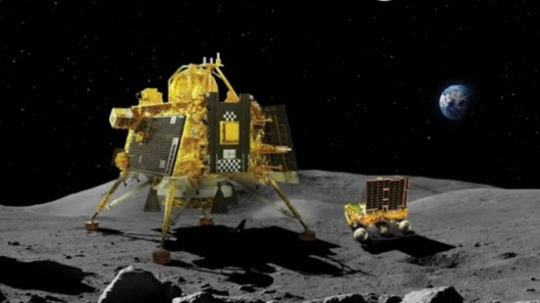
Chandrayaan 3: The Indian Space Research Organisation (ISRO) has released the much-anticipated video of the Pragyan rover ramping down from the Vikram lander and walking on the lunar surface.Pragyan rover coming out of Vikram lander
The rear wheels of the rover, have imprints of the space agency ISRO and the Indian emblem, depicting the Lion Capital of Ashoka at Sarnath. Faint marks can also be seen in the first video shared by the Indian space agency.
Chandrayaan-3 mission detailed timeline
Here is the detailed timeline of all the developments in the Chandrayaan 3 mission.
• July 6: ISRO announces Mission Chandrayaan-3 launch date of July 14 from Sriharikota's second pad.
• July 7: Successful vehicle electrical tests completed.
• July 11: Comprehensive 24-hour 'Launch Rehearsal' simulating the entire launch process concludes.
• July 14: LVM3 M4 vehicle launches Chandrayaan-3 into designated orbit.
• July 15: First orbit-raising manoeuvre successful, reaching 41762 km x 173 km orbit.
• July 17: Second orbit-raising manoeuvre places Chandrayaan-3 at 41603 km x 226 km orbit.
• July 22: Fourth orbit-raising manoeuvre establishes spacecraft in 71351 km x 233 km orbit.
• July 25: Another successful orbit-raising manoeuvre.
• August 1: Chandrayaan-3 inserted into translunar orbit (288 km x 369328 km).
• August 5: Successful lunar orbit insertion (164 km x 18074 km).
• August 6: Lunar orbit lowered to 170 km x 4,313 km.
• August 9: ISRO carefully moves the spacecraft's path lower in its orbit around the moon. It has achieved a lunar orbit of 174 km x 1437 km
• August 14: Chandrayaan-3 gets closer to the moon's surface in another controlled bringing it in a orbit of 150 km x 177 km
• August 16: The Indian spacecraft performs the fifth and final Moon-bound manoeuvre positioning itself in a near circular Lunar orbit of 163*153 km.
• August 17: The landing module, comprising the Vikram lander and Pragyan rover, gets separated from its propulsion system.
• August 18: Chandrayaan 3 successfully completed a 'deboosting' operation that reduced its orbit to 113 km x 157 km
• August 20: The Chandrayaan-3 will make the final orbit adjustment by reducing it to be around 134*25 km, the farthest and nearest point from the moon respectively.
• August 23: ISRO marked history with the successful landing of the Vikram lander. All the systems are performing as intended.
for more information: khabri
2 notes
·
View notes
Text
INDIA HAS JOINED THE MOON CLUB LETS GOOOOO
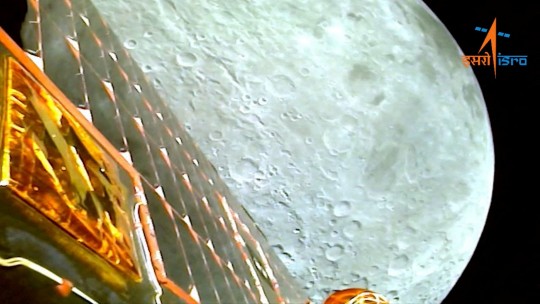
India has landed its Chandrayaan-3 spacecraft on the moon, becoming only the fourth nation ever to accomplish such a feat. The mission could cement India’s status as a global superpower in space. Previously, only the United States, China and the former Soviet Union have completed soft landings on the lunar surface. Chandrayaan-3’s landing site is also closer to the moon’s south pole than any other spacecraft in history has ventured. The south pole region is considered an area of key scientific and strategic interest for spacefaring nations, as scientists believe the region to be home to water ice deposits. The water, frozen in shadowy craters, could be converted into rocket fuel or even drinking water for future crewed missions
Indian Prime Minister Narendra Modi, currently in South Africa for the BRICS Summit, watched the landing virtually and shared broadcasted remarks on the livestream. “On this joyous occasion…I would like to address all the people of the world,” he said. “India’s successful moon mission is not just India’s alone. This is a year in which the world is witnessing India’s G20 presidency. Our approach of one Earth, one family, one future is resonating across the globe. “This human-centric approach that we present and we represent has been welcome universally. Our moon mission is also based on the same human-centric approach,” Modi added. “Therefore, this success belongs to all of humanity, and it will help moon missions by other countries in the future.” India’s attempt to land its spacecraft near the lunar south pole comes just days after another nation’s failed attempt to do the same. Russia’s Luna 25 spacecraft crashed into the moon on August 19 after its engines misfired, ending the country’s first lunar landing attempt in 47 years.
Chandrayaan-3’s journey As Chandrayaan-3 approached the moon, its cameras captured photographs, including one taken on August 20 that India’s space agency shared Tuesday. The image offers a close-up of the moon’s dusty gray terrain. India’s lunar lander consists of three parts: a lander, rover and propulsion module, which provided the spacecraft all the thrust required to traverse the 384,400-kilometer (238,855-mile) void between the moon and Earth. The lander, called Vikram, completed the precision maneuvers required to make a soft touchdown on the lunar surface after it was ejected from the propulsion module. Tucked inside is Pragyan, a small, six-wheeled rover that will deploy from the lander by rolling down a ramp. Vikram used its on board thrusters to carefully orient itself as it approached the lunar surface, and it slowly throttled down its engines for a touchdown just after 6 p.m. IST (8:30 a.m. ET) as applause erupted from the mission control room. The Indian Space Research Organization, or ISRO, later confirmed it had established two-way communication with the spacecraft and shared the first images of the surface captured during the lander’s final descent. The lander, which weighs about 1,700 kilograms (3,748 pounds), and 26-kilogram (57.3-pound) rover are packed with scientific instruments, prepared to capture data to help researchers analyze the lunar surface and deliver fresh insights into its composition.
Dr. Angela Marusiak, an assistant research professor at the University of Arizona’s Lunar and Planetary Laboratory, said she’s particularly excited that the lunar lander includes a seismometer that will attempt to detect quakes within the moon’s interior. Studying how the moon’s inner layers move could be key information for future endeavors on the lunar surface, Marusiak said. “You want to make sure that any potential seismic activity wouldn’t endanger any astronauts,” Marusiak said. “Or, if we were to build structures on the moon, that they would be safe from any seismic activity.” The lander and rover are expected to function for about two weeks on the moon’s surface. The propulsion module will remain in orbit, serving as a relay point for beaming data back to Earth.
2 notes
·
View notes
Text
See 1st photos of the moon's south pole by India's Chandrayaan-3 lunar lander
By Tereza Pultarova
23 August 2023
India's Chandrayan-3 mission has nailed its lunar landing.

The first images from India's Chandrayaan-3 mission taken after the probe's historic moon touchdown reveal a pockmarked surface near the lunar south pole.
The Indian Space Research Organisation (ISRO) shared the images on X, formerly Twitter, on Wednesday (August 23), about four hours after the Chandrayaan-3 spacecraft completed its smooth descent.
The first set of four images were taken by the lander's Horizontal Velocity Camera as it was nearing the surface of the moon.
An additional image from the Landing Imager Camera, shared a little later, shows a glimpse of the landing site, including a portion of the spacecraft's landing leg and its shadow.
"The communication link is established between the Ch-3 Lander and MOX-ISTRAC, Bengaluru," ISRO said in a post on X.
"Chandrayaan-3 chose a relatively flat region on the lunar surface," the agency added in the subsequent post.
The landing made India only the fourth country in history to successfully put a spacecraft on the surface of the moon, after the United States, the former Soviet Union and China.
Chandrayaan-3 is also the first spacecraft in history to touch down near the lunar south pole, an area that is currently attracting the attention of scientists and space agencies from all over the world.
Scientists think that the permanently shadowed polar craters contain water ice trapped in the rocks, which could be extracted and used to support a permanent human presence on Earth's natural companion.
Moreover, these lunar craters could be used to build next-generation telescopes that would allow astronomers to see farther than they can today.
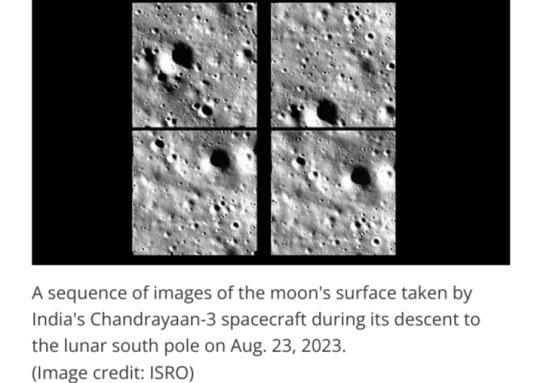
A small rover called Pragyan arrived on board Chandrayaan-3 and will soon deploy and commence its exploration of the exciting region, so many more fascinating images are likely to come soon.
Both the rover and the lander, however, are unlikely to remain operational for more than two weeks, as ISRO doesn't expect the vehicles' batteries to make it through the two-week lunar night.
Chandrayaan-3 was India's second try at landing near the moon's south pole.
The country's first attempt at a lunar touchdown, in September 2019, failed when the Chandrayaan-2 lander crashed into the moon due to a software glitch.
India's triumph comes only three days after Russia lost its Luna-25 mission, its first attempt to put a spacecraft on the moon's surface in 47 years.
Luna-25, too, was aiming for the lunar south pole but crashed into the moon instead after a botched orbital maneuver on Saturday (August 19).
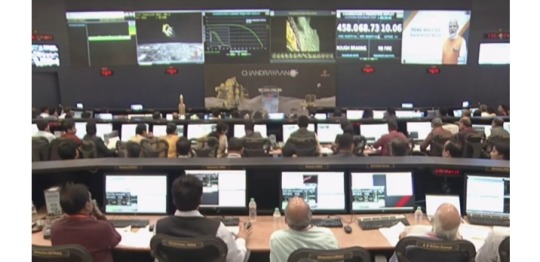
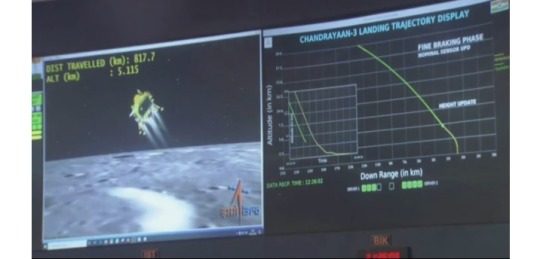
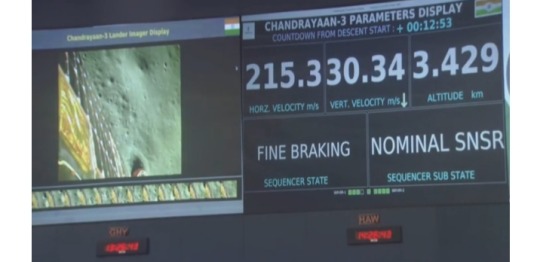
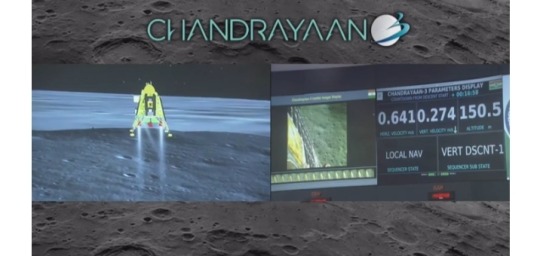

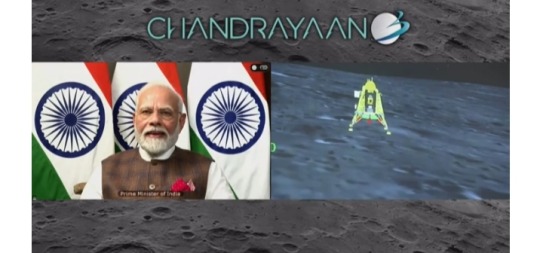
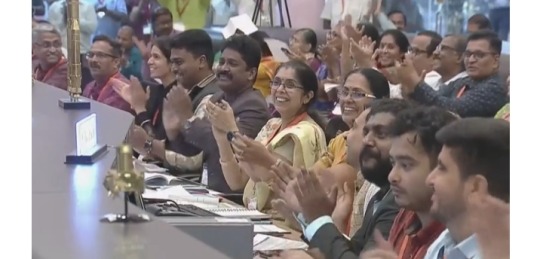
#Chandrayaan-3#Chandrayaan-3 lunar lander#Indian Space Research Organisation (ISRO)#Chandrayaan-3 spacecraft#Horizontal Velocity Camera#Landing Imager Camera#next-generation telescopes#Pragyan#India#moon#lunar landing#spacecraft#moon landing
2 notes
·
View notes
Link
#Chandrayaan-2#Chandrayaan-3#India'slunarexplorationachievements#ISRO#ISROChandrayaan-3mission#Lunarlandingcommunicationmilestone#VikramSarabhai
2 notes
·
View notes
Text

Details about Chandrayan-3
Chandrayaan-3 is the third lunar exploration mission by the Indian Space Research Organisation (ISRO) under the Chandrayaan programme. It consists of a lander named Vikram and a rover named Pragyan, similar to those of the Chandrayaan-2 mission. The mission aims to demonstrate a soft landing on the lunar surface, roving on the Moon, and conducting scientific experiments.
Chandrayaan-3 was launched on 14 July 2023 and entered lunar orbit on 5 August 2023. The lander touched down near the south pole of the Moon on 23 August 2023 at 12:32 UTC, making India the fourth country to successfully land on the Moon and the first to do so near the lunar south pole.
The south pole region of the Moon is of special interest for scientific exploration because it contains large amounts of ice and other resources that could be useful for future human settlements. The rover will explore the terrain and collect data on the lunar environment, while the lander will perform experiments on the surface and subsurface of the Moon.
Here are some key facts about Chandrayaan-3 that you might find interesting:
Chandrayaan-3 is a revised version of Chandrayaan-2, which failed to land on the Moon in 2019 due to a technical glitch. Chandrayaan-3 has improved landing sensors and software to avoid a repeat of the mishap.
Chandrayaan-3 does not have an orbiter, unlike Chandrayaan-2, because the orbiter of Chandrayaan-2 is still functioning and can relay data from the lander and rover. This reduces the cost and complexity of the mission.
Chandrayaan-3 is expected to operate for 14 Earth days or one lunar day, during which it will conduct various experiments and tests. The rover will cover a distance of 500 meters on the lunar surface, while the lander will drill up to 10 centimeters into the ground.
Chandrayaan-3 is part of India’s ambitious plan to explore the Moon and its potential for human habitation. India plans to send a human crew to orbit the Moon by 2025, and eventually establish a permanent lunar base by 2030.
We hope this description helps you understand more about Chandrayaan-3 and its objectives. 😊
#chandrayaan3#chandrayaanlaunch#indian space research organisation#isro#moonmission#chandrayaanlanding
1 note
·
View note
Text
Top 10 Engineering Colleges in Haryana for Future Engineers

Introduction
Are you on the hunt for the best engineering colleges in Haryana to launch your career? You're not alone, and you’re in luck! Haryana is quickly becoming one of India’s emerging education hubs, especially for engineering aspirants.
From centrally-funded institutions to private universities with international collaborations, Haryana’s got a wide range of options for budding engineers. This guide dives into the top 10 engineering colleges in Haryana, highlighting what makes each one special, be it world-class infrastructure, top-tier faculty, or unmatched placement records.
Let’s explore what’s out there and help you make an informed choice that fits your goals.
1. JMIT Radaur – A Legacy of Excellence
Overview
JMIT, short for Seth Jai Parkash Mukand Lal Institute of Engineering and Technology, has consistently ranked among the top engineering colleges in Haryana. Affiliated with Kurukshetra University and approved by AICTE, JMIT has built a solid reputation.
Courses Offered
B.Tech (CSE, ECE, ME, IT, AI & ML)
M.Tech
MBA, MCA
Campus Facilities
Smart classrooms
Central library with 60,000+ books
Wi-Fi enabled hostel
Robotics & Innovation Labs
Industry Connect & Placement
JMIT has built strong relationships with recruiters like Infosys, TCS, Wipro, Capgemini, and Amazon. They also run regular soft-skills training and internships.
Why Choose JMIT?
If you're looking for quality education with practical exposure, JMIT offers the right blend of academics, co-curriculars, and career readiness.
2. NIT Kurukshetra – National Prestige
Overview
A centrally-funded institution, NIT Kurukshetra is one of India’s top engineering colleges and a dream college for many.
Research and Innovation Focus
Funded research by DRDO, ISRO
Multiple patents filed yearly
Incubation cell for startups
Infrastructure Highlights
Central Computer Lab
Dedicated Engineering Departments
Sports Complex & Auditorium
Campus Life
With cultural fests, robotics competitions, and coding marathons, life here is vibrant and intellectually stimulating.
Placement Overview
Average placement packages often exceed ₹10 LPA, especially for CS & ECE.
3. UIET, Kurukshetra University
Background
Established under Kurukshetra University, UIET provides affordable and high-quality engineering education.
Academic Programs
B.Tech in core and emerging streams
Dual Degree Programs
Labs & Learning Tools
Well-equipped labs in mechanical, electrical, and civil departments make UIET stand out.
Industry Collaborations
MOUs with major Indian companies for internships and industrial training.
Notable Alumni
UIET alumni are placed in PSU jobs and global MNCs alike.
4. YMCA University, Faridabad
University Profile
YMCAUST is now officially a university and offers a wide range of B.Tech programs.
Key Departments
Computer Engineering
Electrical & Electronics
Mechanical Engineering
Academic Excellence
Known for rigorous academics and practical approach.
Research Labs and Facilities
IoT & Embedded Systems Lab
Advanced CAD Centre
Career Opportunities
Great track record of placements in Core Engineering, IT, and Consulting.
5. DCRUST, Murthal
Institution Overview
Deenbandhu Chhotu Ram University of Science and Technology is a state university and a go-to choice for engineering in northern Haryana.
Accreditation & Rankings
NAAC ‘A’ Grade
Strong NIRF Rankings in the state
Student Support Systems
Mentorship programs, student chapters of IEEE, and GATE coaching support.
Placement & Training
Recruiters include Maruti Suzuki, Indian Oil, L&T, and Infosys.
Why DCRUST is Future-Ready
Focus on clean energy, sustainability, and AI research makes it a modern choice.
6. Amity University, Gurugram
Private University Snapshot
A UGC-recognized private university known for top-notch infrastructure.
Advanced Curriculum
Industry-ready programs with a focus on practical applications.
International Collaborations
Foreign internships
Student exchange with 30+ universities
Student Life & Hostel Facilities
Modern hostels, sports complexes, and cultural clubs.
Industry-Oriented Approach
Internship programs with IBM, Microsoft, and HCL.
7. BML Munjal University
Vision and Mission
Backed by the Hero Group, BML emphasizes on experiential learning.
Interdisciplinary Focus
Students work on real-world problems, across disciplines.
Entrepreneurial Culture
Incubation and Startup funding programs are part of the curriculum.
Facilities and Mentoring
Guidance from global faculty and in-house mentors.
Career Prospects
Excellent internships and placement support in tech giants.
8. Manav Rachna International Institute of Research and Studies
Overview
One of the oldest private universities with engineering excellence.
Centers of Excellence
In-house SAP, AutoCAD, and AI labs in partnership with industry.
Skill-Based Learning
Regular workshops, certification programs, and hackathons.
International Exposure
Study Abroad programs in Dubai, USA, UK.
Corporate Tie-Ups
Tech Mahindra, Accenture, and IBM recruit from here.
9. NorthCap University, Gurugram
About the University
A tech-forward, student-centric private university.
Project-Based Learning
Hands-on learning and research from Day 1.
Placement Insights
91%+ students placed in the last 3 years.
Life on Campus
A blend of academics, tech fests, sports, and community service.
Future Plans
More international tie-ups and AI-focused programs.
10. Panipat Institute of Engineering & Technology (PIET)
College Overview
One of the fastest-growing private colleges in Haryana.
Strong Industrial Linkages
Associations with industry leaders for internships and projects.
Academic and Non-Academic Ecosystem
From sports tournaments to technical symposiums, student life is vibrant.
Placement Record
Strong in Mechanical, Civil, and IT engineering placements.
Why PIET is a Top Pick
Affordable fees and high placement ratio make it a value-for-money choice.
Comparison List of Top 10 Engineering Colleges in Haryana
1. NIT Kurukshetra
NIRF Ranking: Top 50
Fees (Approx/Year): ₹1.25 Lakh
Average Placement: ₹10 LPA
2. JMIT Radaur
NIRF Ranking: Not Available
Fees (Approx/Year): ₹90,000
Average Placement: ₹4.5 LPA
3. UIET, Kurukshetra University
NIRF Ranking: Not Available
Fees (Approx/Year): ₹75,000
Average Placement: ₹3.5 LPA
4. YMCA University, Faridabad (YMCAUST)
NIRF Ranking: 101–150
Fees (Approx/Year): ₹1 Lakh
Average Placement: ₹4.2 LPA
5. DCRUST, Murthal
NIRF Ranking: Not Available
Fees (Approx/Year): ₹70,000
Average Placement: ₹3.8 LPA
6. Amity University, Gurugram
NIRF Ranking: Not Available
Fees (Approx/Year): ₹1.8 Lakh
Average Placement: ₹5 LPA
7. BML Munjal University
NIRF Ranking: Not Available
Fees (Approx/Year): ₹2.2 Lakh
Average Placement: ₹6.5 LPA
8. Manav Rachna International Institute of Research and Studies (MRIIRS)
NIRF Ranking: Not Available
Fees (Approx/Year): ₹1.5 Lakh
Average Placement: ₹4 LPA
9. NorthCap University, Gurugram
NIRF Ranking: Not Available
Fees (Approx/Year): ₹1.9 Lakh
Average Placement: ₹4.5 LPA
10. Panipat Institute of Engineering & Technology (PIET)
NIRF Ranking: Not Available
Fees (Approx/Year): ₹1 Lakh
Average Placement: ₹3.8 LPA
Things to Consider When Choosing Engineering Colleges in Haryana
Accreditation (AICTE/UGC/NAAC)
Campus Placement support
Practical exposure opportunities
Hostel and safety facilities
Budget and ROI
FAQs
1. What are the eligibility criteria for engineering colleges in Haryana?
Ans: Most require 10+2 with Physics, Chemistry, and Math with a minimum of 45-50% and JEE Main scores.
2. Which is the most affordable engineering college in Haryana?
Ans: JMIT and DCRUST offer quality education at affordable fees.
3. How do placements compare across public vs. private institutions in Haryana?
Ans: Public institutions like NIT offer better average salaries, but top private universities also offer good packages.
4. Can I get hostel facilities in engineering colleges in Haryana?
Ans: Yes, all top colleges offer hostel facilities with modern amenities.
5. Which engineering branch has the best scope currently?
Ans: CSE, AI & ML, and JMIT are currently in high demand.
Conclusion
So there you have it, our handpicked list of the top 10 engineering colleges in Haryana. Whether you're looking for affordable education, research opportunities, or corporate exposure, there's a college on this list that's perfect for you.
Take time to explore, visit campuses if you can, and talk to alumni. Remember, the right college can truly set the stage for a fulfilling engineering career.
0 notes
Text
National Institute of Technology—[NIT], Raipur
A Premier Institute for Technical Excellence and Innovation
The National Institute of Technology, Raipur (NIT Raipur), is one of the most prestigious engineering institutions in India. Established in 1956 as the Government College of Mining and Metallurgy, it was later upgraded to the status of a National Institute of Technology in 2005. Functioning under the Ministry of Education, Government of India, NIT Raipur has grown to become a leading center for academic excellence, innovation, and research in Central India.
Situated in Raipur, the capital city of Chhattisgarh, the institute offers a dynamic learning environment that combines a strong foundation in science and engineering with real-world application and research exposure.
Campus and Infrastructure
The NIT Raipur campus spans over 100 acres and is equipped with all the facilities necessary for a modern technical education. The campus includes well-maintained academic blocks, hostels, labs, and recreational areas.
Key Facilities:
Modern lecture halls and digital classrooms
State-of-the-art laboratories in each department
Central Library with access to thousands of books, e-journals, and digital resources
High-speed internet and computing infrastructure
Central Computer Centre
Well-furnished hostels with mess and recreational facilities
On-campus sports complex, gym, bank, post office, and health center
The infrastructure is designed to support both academic learning and extracurricular development, ensuring a well-rounded educational experience.
Academic Programs
NIT Raipur offers a wide range of programs at the undergraduate, postgraduate, and doctoral levels. These are designed to prepare students to meet the evolving demands of industries and academia.
Undergraduate Programs (B.Tech and B.Arch):
Biomedical Engineering
Biotechnology
Civil Engineering
Chemical Engineering
Computer Science and Engineering
Electrical Engineering
Electronics and Telecommunication Engineering
Information Technology
Mechanical Engineering
Metallurgical and Materials Engineering
Mining Engineering
Architecture (B.Arch—5-year program)
Postgraduate Programs (M.Tech, M.Sc, MCA):
Structural Engineering
Thermal Engineering
VLSI Design
Information Security
Power Systems
Control Systems
Computer Applications (MCA)
M.Sc. in Physics, Chemistry, Mathematics, and Applied Geology
Doctoral Programs (Ph.D.):
Ph.D. programs are available in all engineering disciplines, sciences, and allied fields. NIT Raipur supports full-time and part-time doctoral research.
Faculty and Learning Methodology
NIT Raipur is supported by a team of highly qualified faculty members with academic and research credentials from leading institutions. The teaching approach is student-centric, combining theory with practical exposure and research-based learning.
Key Features:
Project-based coursework
Live industry projects
Interdisciplinary electives
Research-integrated learning
Guest lectures, seminars, and workshops
Faculty members are also actively involved in national and international research collaborations.
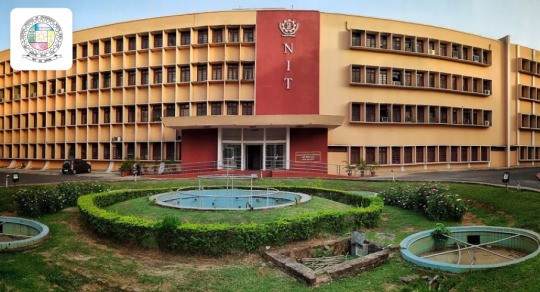
Research and Development
NIT Raipur places a strong emphasis on research, innovation, and development. The institute receives funding from government bodies such as DST, DRDO, ISRO, AICTE, CSIR, and ICMR to promote advanced research.
Research Areas:
Artificial Intelligence and Machine Learning
Smart Grids
Renewable Energy
Robotics and Automation
Advanced Materials
Sustainable Infrastructure
Research outcomes are published in reputed journals, and students are encouraged to participate in national and international conferences.
Industry Collaboration and Internships
NIT Raipur maintains close ties with the corporate sector through its Industry-Institute Partnership Cell and Training & Placement Cell. These relationships help students gain practical experience through internships and industrial visits.
Highlights:
Internships in core and IT industries
Live projects with industry experts
Memorandums of Understanding (MoUs) with leading firms
Corporate mentorship programs
Industry-sponsored labs and research centers
The exposure gained during internships significantly boosts employability and job readiness.
Placements
NIT Raipur has a strong placement record. Students from all branches consistently receive job offers from top multinational companies and Indian corporations. The Training and Placement Cell facilitates campus recruitment and career preparation sessions.
Top Recruiters Include:
Microsoft
Amazon
Infosys
Accenture
Wipro
Deloitte
TCS
JSW Steel
Vedanta
L&T
Cognizant
HCL
Mahindra Group
The institute also sees a significant number of students pursuing higher studies in India and abroad after graduation.
Student Life and Campus Culture
Student life at NIT Raipur is vibrant, dynamic, and inclusive. The institute hosts a variety of cultural, technical, and sports events throughout the academic year.
Major Events:
Aavartan – Annual Techno-Management Fest
Eclectika – Annual Cultural Festival
Sports Meets and Competitions
Technical Clubs: Coding Club, Robotics, AI & ML Club
Literary and Art Societies
NSS and NCC Units
These activities foster leadership, creativity, and teamwork among students.
International Exposure
Although primarily a national institute, NIT Raipur is gradually expanding its global presence. Students participate in international competitions and present research in conferences abroad. The institute is working toward establishing formal international partnerships and student exchange programs.
Admission Process
Admission to undergraduate programs is through the Joint Entrance Examination (JEE Main) followed by centralized counseling by JoSAA (Joint Seat Allocation Authority). Postgraduate admissions are through GATE, NIMCET, and CCMT processes depending on the course.
Eligibility:
B.Tech/B.Arch: 10+2 with PCM + JEE Main
M.Tech: B.E./B.Tech + GATE
MCA: Graduation + NIMCET
Ph.D.: Postgraduate degree + entrance test/interview
Being a centrally funded institute, NIT Raipur admits students from all over India and provides reservation benefits as per government norms.
Vision and Mission
Vision: To be a center of excellence in technical education, research, and innovation that produces technically competent and socially responsible professionals.
Mission:
Deliver quality education through curriculum and innovation
Promote research and development in emerging technologies
Foster industry-academia partnerships
Develop ethical, skilled, and globally competent graduates
Conclusion
The National Institute of Technology, Raipur, continues to be a beacon of quality technical education in India. With its focus on academic excellence, research innovation, and holistic development, NIT Raipur empowers students to become engineers, scientists, and leaders who contribute meaningfully to society. For students aspiring to build strong foundations in technology and engineering, NIT Raipur is a gateway to a bright future.
1 note
·
View note
Photo

At a latest panel at Indian Institute Of Technology (IIT) Madras, administrators from 5 of India’s prime engineering establishments supplied a prescription: it’s time to maneuver past the coding craze. They urged college students to pursue sustainability, semiconductors, and core engineering of their careers. “Put the nation first,” stated one. Others described the herd mentality drawing prime rankers into pc science. AI goes to crush entry-level white-collar hiring over the subsequent 24 to 36 months, says a report. (Representative picture) Their frustration is actual. They see firsthand the hollowing out of foundational disciplines and the skewed incentives. And they’re not flawed to sound the alarm, although it's not a brand new one. Leaders have decried each the mind drain and the stampede in the direction of pc science for many years. I perceive the strain between aspiration, alternative, and return. India’s future is value betting on however appeals to nation-building alone is probably not sufficient to redirect our greatest and brightest. Career decisions are deeply private, formed by monetary strain and rewards, household expectations, and perceived stability. Consider the stark actuality: a contemporary pc science graduate at a tech firm can earn 3 times or greater than a PhD-trained analysis engineer or scientist. Until we tackle this wage hole, patriotic appeals will fall quick. Many educated college students go overseas to check and work. They are globally cellular and wanted by establishments in lots of international locations. If the state of affairs turns into untenable for a lot of, we have to actively seize the chance to convey them again. But we can not depend on their return simply because issues didn’t work out overseas. There are two indicators that make me hopeful that is India’s second. They are pushed by two forces already in movement. The first is that the bottom beneath coding jobs is shifting. A latest Washington Post report confirmed how AI is quickly remodeling India’s 280-billion-dollar outsourcing sector. Bots now reply queries, generate fundamental code, information name centre brokers in actual time, and monitor high quality with out human oversight. “AI goes to crush entry-level white-collar hiring over the subsequent 24 to 36 months,” an trade veteran stated within the report. The first wave will hit graduates in entry-level, repetitive roles, hardly the kind that administrators of elite establishments are anxious about. The variety of folks wanted to do those self same roles might shrink. But automation and AI transfer up the worth chain. Without transformation, even jobs that appear safe right now is probably not tomorrow. So maybe science and core engineering aren't simply idealistic alternate options. They could also be sensible long-term bets for graduating college students. But for this to be true, there must be a scaffolding to help them. If we would like extra college students to maneuver towards core science and engineering, we have to make these paths enticing and viable. In a latest interview with The Hindu, Nobel laureate Venki Ramakrishnan stated that India’s analysis and growth (R&D) funding as a fraction of gross home product (GDP) is way beneath international locations like South Korea, and that it's going to not be aggressive and not using a substantial improve. Currently, India spends roughly 0.7 % of GDP on R&D, in comparison with South Korea’s 5 p.c and China’s 2.7 %. We ought to goal 2 p.c by 2030, a practical benchmark that China achieved throughout its scientific transformation within the 2000s. We want extra state-of-the-art analysis amenities with international-grade tools, high-speed computing clusters accessible to researchers nationwide, and modernised libraries with world database entry. Think of what the Indian Space Research Organisation (ISRO) achieved with targeted funding. Similar dedication to supplies scienc
0 notes
Text
Ammonium Perchlorate Production Cost Report: Strategic Insights for Aerospace and Defense Supply Chains

Procurement Resource, a global leader in market intelligence and procurement advisory, is proud to release its latest Ammonium Perchlorate Production Cost Report. This detailed report serves as a critical resource for investors, defense contractors, chemical manufacturers, and procurement strategists involved in the production or sourcing of Ammonium Perchlorate (AP). It provides end-to-end insights into production economics, raw material inputs, technical processing steps, infrastructure requirements, and global market trends.
Ammonium Perchlorate: A Strategic Energetic Compound
Ammonium Perchlorate (NH₄ClO₄) is an oxidizing agent primarily used as a key propellant ingredient in solid rocket fuels, missiles, space launch systems, and pyrotechnics. Due to its high oxygen content and reactivity, it enables high-thrust propulsion when combined with fuels such as aluminum powder and binders like HTPB (Hydroxyl-Terminated Polybutadiene).
Given its critical application in defense and space sectors, Ammonium Perchlorate is classified as a strategic compound subject to government regulation and restricted export controls in several countries. Its importance is amplified by global geopolitical developments, increasing investment in space research, and defense modernization programs.
Scope of the Production Cost Report
The Ammonium Perchlorate Production Cost Report by Procurement Resource offers a holistic perspective for businesses aiming to:
Establish or expand AP production facilities
Improve cost-efficiency and plant performance
Evaluate investment risks and ROI
Align operations with environmental and safety standards
The report includes:
Raw material cost analysis
Technical process overview
Plant infrastructure and machinery layout
Utility and labor requirements
Regulatory, environmental, and safety considerations
Financial modeling and profit projections
Global Market Overview and Outlook
The demand for Ammonium Perchlorate is heavily influenced by:
Defense and missile programs in countries such as the USA, India, Russia, China, and Israel
Commercial space launch activity, driven by companies like SpaceX, ISRO, and ESA
Civil applications such as flares, airbags, mining charges, and fireworks (though increasingly regulated)
While North America and Europe emphasize safety and supply security, Asia-Pacific—notably India and China—continues to dominate production volumes due to growing defense budgets and government-backed manufacturing initiatives.
Raw Material and Input Cost Analysis
Ammonium Perchlorate is synthesized from Ammonia or Ammonium Hydroxide and Perchloric Acid (HClO₄) through a controlled chemical reaction. The report breaks down costs and sourcing trends of key feedstocks:
Ammonia (NH₃): Derived from natural gas or hydrogen via the Haber-Bosch process
Perchloric Acid: Usually produced by the electrolysis of sodium perchlorate or through distillation methods
Water (high purity)
Energy and reagents used in crystallization, filtration, and drying
The volatility in ammonia pricing (tied to natural gas markets) and supply restrictions on perchlorates are thoroughly analyzed.
Production Process: A Technical Walkthrough
Ammonium Perchlorate is produced through the neutralization reaction of perchloric acid with ammonia or ammonium hydroxide, followed by purification and crystallization.
Step-by-Step Manufacturing Process:
Neutralization Reaction Perchloric acid is slowly added to an aqueous solution of ammonia under controlled temperature and pH conditions, forming ammonium perchlorate in solution.
Crystallization The supersaturated solution is cooled or subjected to vacuum evaporation to initiate crystallization of high-purity AP crystals.
Filtration and Washing The formed crystals are filtered and washed with chilled deionized water to remove impurities.
Drying Crystals are dried under low temperature in explosion-proof dryers to prevent decomposition and maintain structural stability.
Milling and Classification Dried AP is milled into the desired particle size range (coarse or fine) for specific propellant applications.
The report includes material balance sheets, safety procedures, and recommended process controls for batch and continuous setups.
Plant Setup and Equipment Specification
Given the hazardous nature of AP production, strict safety standards must be followed. The report outlines the key machinery and infrastructure required:
Reactor vessels (non-metallic or corrosion-resistant)
Crystallizers and agitators
Explosion-proof filtration and drying systems
Automated pH and temperature monitoring systems
Material handling and storage equipment for oxidizers
Cleanroom or classified zones for drying and packaging
Detailed floor plans, space estimates, zoning regulations, and utility load requirements (electricity, water, steam, HVAC) are discussed in the report.
Utilities and Human Capital Requirements
Utility Needs:
Industrial-grade power backup systems
Water purification and recirculation systems
Steam and chilled water lines
HVAC with HEPA filtration
Waste neutralization systems
Manpower Requirements:
Process engineers and chemical handlers
Plant operators and safety officers
Quality assurance (QA) and laboratory personnel
Environmental and compliance managers
Skillset levels vary based on automation—fully automated setups reduce labor dependency but require skilled technical oversight.
Regulatory, Environmental, and Safety Compliance
Because Ammonium Perchlorate is an energetic material and environmental pollutant, production must adhere to multiple global and regional regulations:
REACH and CLP compliance in the EU
EPA and ATF regulations in the U.S.
Explosive Materials Act in India
Storage and handling protocols under fire and explosive safety standards
The report includes cost estimates for regulatory approvals, licensing, environmental impact assessments (EIA), effluent treatment, and hazardous waste disposal.
Financial Overview and Economic Viability
The report models various financial scenarios based on production capacity, location, and input cost variability. Highlights include:
Capital Expenditure (CapEx):
Land acquisition and construction
Equipment procurement and installation
Licensing and safety certification
Operating Expenditure (OpEx):
Raw materials and chemicals
Labor and training
Utilities and maintenance
Compliance and QA/QC
Profitability Metrics:
Cost of production (per kg or per ton)
Gross margins and EBITDA
ROI and IRR over 5–10 years
Break-even point and payback period
These metrics help stakeholders understand scalability, pricing flexibility, and risk mitigation strategies.
Sustainability and Innovation Trends
The Ammonium Perchlorate industry is increasingly exploring greener manufacturing routes, such as:
Recycling spent perchlorates
Closed-loop water and solvent recovery systems
Safer substitutes and hybrid oxidizers for non-military applications
Emission reduction and explosion-proof automation
The report also discusses emerging market opportunities such as eco-friendly propellants for micro-launchers and CubeSats, and potential AP alternatives in green space propulsion.
Why Choose Procurement Resource?
Procurement Resource is the partner of choice for over 500 global enterprises seeking transparency, cost-efficiency, and operational resilience in their supply chains. Our production cost reports are:
Data-driven and process-specific
Tailored for strategic decision-making
Backed by chemical engineering expertise
Regularly updated to reflect market shifts
From production plant feasibility to supply chain benchmarking, our reports empower decision-makers with the insights needed for competitive advantage.
Request a Free Sample Report Today
For stakeholders exploring opportunities in the Ammonium Perchlorate industry—from defense contractors to chemical OEMs—the Ammonium Perchlorate Production Cost Report by Procurement Resource is an indispensable planning tool.
Request a free sample: https://www.procurementresource.com/production-cost-report-store/ammonium-perchlorate/request-sample
Contact Information
Company Name: Procurement Resource Contact Person: Ashish Sharma (Sales Representative) Email: [email protected] Location: 30 North Gould Street, Sheridan, WY 82801, USA Phone Numbers: UK: +44 7537171117 USA: +1 307 363 1045 Asia-Pacific: +91 1203185500
#Ammonium Perchlorate#solid rocket fuels#global market trends#chemical manufacturers#procurement strategists#aluminum powder#ISRO#ESA#SpaceX#ammonia
0 notes
Text
Black Box's GPS-Based Waste Management Fleet Software in India
Waste management is an essential requirement in the present-day urbanising India. As the cities have grown in population density and the number of services offered by the municipality, the task of managing the garbage collection fleets has become more complicated than ever before. Local governing systems and waste collection agents encounter many operational challenges--in the form of inefficiencies in routing, loss of fuel, and the issue of maintenance and regulatory compliance. That is when Waste Management Fleet Management Systems steps in.
Businesses such as BlackBox GPS, which provides Waste Management Fleet Software solutions as the leading firm in India, are assisting towns in making their waste collection process efficient by using smart technology. Such solutions have been used to handle complete fleets in real-time, safety, minimisation of costs and simplification of overall operations.
Key Benefits of Waste Management Fleet Systems
Advanced Waste Management Fleet Tracking Systems deliver elegant solutions to universal problems in waste collecting- maximising efficiency, cutting expenses and increasing transparency in the daily operations.
Optimisation of Routes: Intelligent routing decreases fuel consumption, heightens pickups and minimises wasted bins.
Vehicle Maintenance: Breakdowns are avoided, and vehicle lifetimes are prolonged through Predictive alerts.
Fuel Monitoring: Monitors to improve fuel use and minimise wastage, block fuel theft.
Transparency & Accountability: Tracks bin picks and adherence to the route, and driver behaviour.
Regulatory Compliance: Timely inspection, checking emissions, and observing safety rules.
Data Management: Collects all information in one place, helping to make better decisions and operational plans.
Challenges in Waste Management Fleet Operations
In the absence of digital solutions, there is a lack of waste fleet operations as follows:
Challenge in monitoring several vehicles
Real-time visibility deficiency
Inadequate route management
Reckless driving and late services
The frequent breakdowns and consumption of fuel
Non-compliance Failure
Poor reporting of data and decision-making
The problems lead to cost increase, operational delays and customer dissatisfaction.
Comprehensive Solution by BlackBox GPS
BlackBox GPS has the most reliable waste management tracking platform in India. It integrates real-time GPS tracking and monitoring, fuel analytics, route planning, predictive maintenance with driver monitoring. It does not require separate anti-theft equipment or programs, the built-in BlackBox system can provide both safety and schedule and analytics services.
Key benefits include:
Live tracking of trucks with zone-based alerts
Notifications when vehicles overstay at collection points
Driver behaviour monitoring to prevent rash driving
Fuel usage tracking to reduce costs and detect theft
Predictive maintenance to avoid service delays
Data-driven dashboards for efficient fleet planning
BlackBox GPS - Transforming Waste Management in India with Smart Fleet Tracking Solutions
Established in 2008, BlackBox GPS Technology Pvt Ltd is a leading provider of GPS-based fleet management solutions for waste management in India. We are one of the first companies to receive AIS 140 IRNSS certification and partner with major telecom providers like Google, Airtel, BSNL, and Jio to ensure seamless connectivity. Our company’s real-time tracking and data-driven insights help optimise routes, cut fuel costs, reduce delays, and streamline waste collection for municipalities and private operators.
Certified with AIS 140, ARAI, ISO 9001, 14001, 27001 & IATF 16949.
Trusted by 10,000+ clients across India.
Partnered with ISRO, DHBVN, Haryana & Punjab Police.
Early adopter of GPS fleet tech for Smart City & Swachh Bharat.
Provides nationwide support and personalised service.
In-house hardware and software development for full control.
0 notes
Text
Gujarat’s SpaceTech Policy: Dholera to Host Satellite Launchpad!

After unveiling SpaceTech Policy, Gujarat plans satellite launchpad in Kutch or Dholera
Gujarat Charts a New Orbit with India’s First SpaceTech Policy
In a visionary leap toward the future, Gujarat has become the first state in India to unveil a dedicated SpaceTech Policy — a bold move aimed at transforming the state into a hub for space innovation and private sector participation.
As part of this forward-looking roadmap, the state government is now gearing up to establish a satellite launchpad, with Kutch and Dholera emerging as the frontrunners for this strategic infrastructure. This marks a critical step in positioning Gujarat at the heart of India’s expanding space ecosystem.
Recognizing the complexity and precision required in such an endeavor, Gujarat plans to collaborate closely with ISRO, the Central Government, and other national agencies, ensuring regulatory alignment and seamless implementation.
The initiative gains further momentum with In-SPACe — India’s single-window body for space sector privatization — being headquartered in Ahmedabad. In-SPACe has already shown keen interest, viewing this move as perfectly aligned with its mission to open up India’s space infrastructure to startups and private innovators.
Gujarat’s SpaceTech Policy promises a well-rounded support system, offering both financial incentives and logistical assistance for companies engaged in satellite manufacturing, component production, control center development, and ground station operations. With this policy in place, the government aims to catalyze a new wave of space-related ventures and R&D in the state.
By establishing its own launchpad, Gujarat is not just reaching for the skies — it’s laying the groundwork to be a launch point for India’s next generation of space missions.
#dholera#dholera sir#dholera smart city#dholera smart city project#plots in dholera sir#dholera residential plot price#dholera sir investment#land prices in dholera sir#dholera smart city plot booking#dholera sir city#rudraksha smart homes#rudraksha properties
1 note
·
View note
Text
🧳Complete Guide to Top 10 Educational Destinations Near Bangalore (With Tejas Travels & Expert Planning Tips)

Education today goes far beyond the classroom. In fact, over 63% of Indian schools (according to NCERT) conduct annual field trips to support experiential learning. From science museums to wildlife reserves, Karnataka offers rich and varied educational destinations.
If you're planning a student trip from Bangalore, whether for science, culture, or history — this is your complete, no-fluff guide. And yes, Tejas Travels, one of Bangalore’s most trusted bus rental companies, is your go-to for safe, affordable, and organized travel 🚌
🌍Why Educational Trips Near Bangalore Matter More Than Ever
Today’s learners need more than textbooks. The New Education Policy (NEP 2020) encourages “experiential, cross-disciplinary learning”, urging schools to take students out into the world 🌱
From ISRO museums to Hampi ruins, educational travel exposes students to real-world applications of what they learn. This is why schools across Bangalore rely on professional bus rental services like Tejas Travels for student safety and convenience.
📌Planning an Educational Tour? Here's Where to Begin
🎒Choose an objective: Science, History, Ecology or Art 🚍Select a trusted transport partner like Tejas Travels for safe, hygienic bus transportation 📅 Pick the right time — October to February is ideal for most outdoor trips 💼 Inform parents, and organize permission forms and guides
From coach rental to full-package planning, Tejas Travels offers curated school tour options with itinerary, logistics and safety protocols.
🔬#1: Visvesvaraya Industrial & Technological Museum – Touch, Learn & Explore
Located right in the heart of Bangalore, this iconic museum is named after Sir M. Visvesvaraya, India’s engineering pioneer. Over 1 million students visit annually to interact with models in physics, chemistry, robotics and mechanics 🛠️
It's aligned with NCERT & CBSE curriculum, making it a top pick for educational trips. Tejas Travels offers travel bus rental services tailored for school groups visiting here.
🌌#2: Jawaharlal Nehru Planetarium – Stargazing Made Scientific
Operated by the Bangalore Association for Science Education, this is a favorite among schools aiming to teach space science and astronomy. With simulations of planetary motion, eclipse demos and sky shows, it’s a thrilling mix of education and wonder 🌠
👨🚀 Link to real-world entity: ISRO's satellite launches and lunar missions 🚌 Safe, structured visits with Tejas Travels' bus hire services for school tours
🛩️#3: HAL Aerospace Museum – Fly Through India’s Aviation History
Established by Hindustan Aeronautics Limited, this museum is the first of its kind in India. With fighter jets, aircraft engines, and ATC simulators, students get an up-close view of India’s aviation achievements 🚀
HAL and ISRO form India's defense and space research backbone — this museum brings those real-life missions to students. Use Tejas Travels’ coach rental for large school groups and smooth logistics.
🧪#4: Raman Research Institute – Legacy of a Nobel Laureate
Founded by C.V. Raman, this institute is a hidden gem for students passionate about physics and research. It’s home to projects in astrophysics and quantum optics 🔬
👨🏫 Did you know? C.V. Raman won the Nobel Prize in Physics in 1930 for his work on light scattering — the ‘Raman Effect’.
Tejas Travels offers tailored bus rental service for school visits to academic institutions like this.
🐅#5: Bannerghatta Biological Park – Biology That Breathes
Just 22 km from Bangalore, this is more than a zoo. It’s a living biology lab, home to tigers, elephants, and India’s largest butterfly park 🐘🦋
Teachers can align the trip with NCERT chapters on ecology, biodiversity and conservation. Use bus services from Tejas Travels for safe wildlife trips.
🏛️#6: Hampi – The Ruins That Speak History
Recognized by UNESCO, Hampi is a must-visit for history and archaeology students. The stone chariots, temple ruins and ancient bazaars reveal the grandeur of the Vijayanagara Empire 🏺
🏛️ Taught in: CBSE Class 7-10 History 🚍 Recommended by schools across Karnataka ✨ Tip: Opt for a weekend trip with overnight stay. Tejas Travels offers full-fledged travel bus rental for such long-distance educational tours.
🕍#7: Belur & Halebidu – Temples That Teach Art and Engineering
Famous for Hoysala architecture, these temples feature detailed stone carvings, geometry, and narrative art. Great for students learning history, architecture, and mathematics in art forms 🧱
Cultural preservation, ASI-guided tours and regional heritage discussions make it an enriching visit.
🎨#8: National Gallery of Modern Art – Art Beyond the Canvas
Art students love NGMA Bangalore for its collection of Raja Ravi Varma, Rabindranath Tagore, Amrita Sher-Gil, and more. It’s not just a gallery, but a journey through India’s modern history via brushstrokes and installations 🎨
Best for: High school students in arts or humanities Easy access via Tejas Travels’ bus rental service for educational institutions
🎭#9: Janapada Loka – Karnataka’s Living Folk Museum
This museum captures the folk traditions of Karnataka, including puppetry, music, instruments, and costumes. Students studying sociology, anthropology or art find this trip especially meaningful.
This is a culturally immersive trip. Tejas Travels provides bus hire for school cultural excursions — ideal for students from both rural and urban schools.
🐦#10: Ranganathittu Bird Sanctuary – Learning Ecology in Real-Time
Home to migratory birds from Siberia and North America, this sanctuary is a real-world lab for biology, geography and environmental science 🕊️
Spot: Painted storks, spoonbills, pelicans, kingfishers Rangers offer ecology-based talks approved by the Karnataka Forest Department
🚍 Schools use Tejas Travels’ bus transportation services to manage this peaceful, early morning day trip with zero hassle.
🚍Why Tejas Travels is the #1 Choice for Educational Trips from Bangalore
🎯 Over 25 years of experience in school transportation 🛡️ Fully insured, sanitized, and GPS-enabled fleet 🚌 Available for bus rental, coach hire, and long-route travel 💼 Supports custom itineraries for curriculum-based learning
Whether it’s a wedding bus, weekend trip or week-long school tour, Tejas Travels’ bus rental service ensures peace of mind for parents, teachers, and institutions alike.
🎓Your Learning Adventure Begins With Just One Ride
Each trip is a story. A physics demo, a planetarium sky show, a glimpse of ancient temples — all of it becomes memory, inspiration, and learning.
Want to plan your school's next educational tour? 👉 Contact Tejas Travels for safe, cost-effective bus rental and school trip planning 📞 Book Now | 🧾 Get a Custom Quote
0 notes